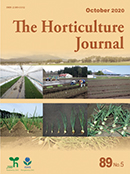89 巻, 5 号
選択された号の論文の16件中1~16を表示しています
- |<
- <
- 1
- >
- >|
原著論文
-
原稿種別: Original Articles
2020 年 89 巻 5 号 p. 509-515
発行日: 2020年
公開日: 2020/10/30
[早期公開] 公開日: 2020/07/23PDF形式でダウンロード (2149K) HTML形式で全画面表示 -
原稿種別: Original Articles
2020 年 89 巻 5 号 p. 516-524
発行日: 2020年
公開日: 2020/10/30
[早期公開] 公開日: 2020/06/27PDF形式でダウンロード (985K) HTML形式で全画面表示 -
原稿種別: Original Articles
2020 年 89 巻 5 号 p. 525-529
発行日: 2020年
公開日: 2020/10/30
[早期公開] 公開日: 2020/09/17PDF形式でダウンロード (609K) HTML形式で全画面表示 -
原稿種別: Original Articles
2020 年 89 巻 5 号 p. 530-536
発行日: 2020年
公開日: 2020/10/30
[早期公開] 公開日: 2020/07/23PDF形式でダウンロード (2278K) HTML形式で全画面表示 -
原稿種別: Original Articles
2020 年 89 巻 5 号 p. 537-544
発行日: 2020年
公開日: 2020/10/30
PDF形式でダウンロード (5865K) HTML形式で全画面表示 -
原稿種別: Original Articles
2020 年 89 巻 5 号 p. 545-552
発行日: 2020年
公開日: 2020/10/30
[早期公開] 公開日: 2020/07/14PDF形式でダウンロード (3331K) HTML形式で全画面表示 -
原稿種別: Original Articles
2020 年 89 巻 5 号 p. 553-566
発行日: 2020年
公開日: 2020/10/30
[早期公開] 公開日: 2020/06/27PDF形式でダウンロード (991K) HTML形式で全画面表示 -
原稿種別: Original Articles
2020 年 89 巻 5 号 p. 567-574
発行日: 2020年
公開日: 2020/10/30
[早期公開] 公開日: 2020/07/23PDF形式でダウンロード (1762K) HTML形式で全画面表示 -
原稿種別: Original Articles
2020 年 89 巻 5 号 p. 575-585
発行日: 2020年
公開日: 2020/10/30
[早期公開] 公開日: 2020/09/17PDF形式でダウンロード (1219K) HTML形式で全画面表示 -
原稿種別: Original Articles
2020 年 89 巻 5 号 p. 586-592
発行日: 2020年
公開日: 2020/10/30
[早期公開] 公開日: 2020/06/27PDF形式でダウンロード (567K) HTML形式で全画面表示 -
原稿種別: Original Articles
2020 年 89 巻 5 号 p. 593-601
発行日: 2020年
公開日: 2020/10/30
[早期公開] 公開日: 2020/06/06PDF形式でダウンロード (1187K) HTML形式で全画面表示 -
原稿種別: Original Articles
2020 年 89 巻 5 号 p. 602-608
発行日: 2020年
公開日: 2020/10/30
[早期公開] 公開日: 2020/06/20PDF形式でダウンロード (580K) HTML形式で全画面表示 -
原稿種別: Original Articles
2020 年 89 巻 5 号 p. 609-618
発行日: 2020年
公開日: 2020/10/30
[早期公開] 公開日: 2020/08/06PDF形式でダウンロード (5782K) HTML形式で全画面表示 -
原稿種別: Original Articles
2020 年 89 巻 5 号 p. 619-627
発行日: 2020年
公開日: 2020/10/30
[早期公開] 公開日: 2020/09/17PDF形式でダウンロード (1830K) HTML形式で全画面表示 -
原稿種別: Original Articles
2020 年 89 巻 5 号 p. 628-638
発行日: 2020年
公開日: 2020/10/30
[早期公開] 公開日: 2020/07/22PDF形式でダウンロード (3667K) HTML形式で全画面表示
CORRIGENDUM
-
原稿種別: Corrigendum
2020 年 89 巻 5 号 p. 639
発行日: 2020年
公開日: 2020/10/30
[早期公開] 公開日: 2020/07/22PDF形式でダウンロード (140K) HTML形式で全画面表示
- |<
- <
- 1
- >
- >|
